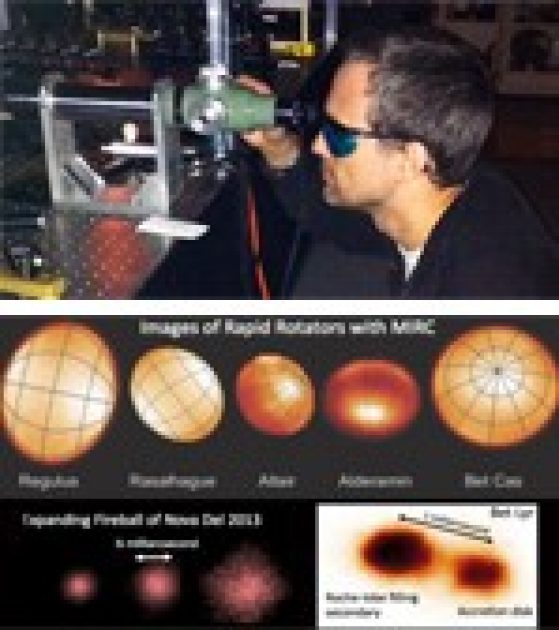Thank you for your interest in supporting Michigan Astronomy! From illuminating how black holes shape their native galaxies to explaining why alien “exoplanets” look and act as they do, our faculty and students continue to push the limits of our ability to observe and understand.
We’ve recently signed an agreement with Swift, giving us unique access to NASA’s multi-wavelength orbital telescope for both planned observations and rapid responses to exciting events, such as a black hole shredding a star. We are working to get similar access in millimeter radio and have signed on as an institutional member of the Dark Energy Spectroscopic Instrument, putting us at the center of efforts to crack the mysterious nature of dark energy.
As new instruments redefine the boundaries of astronomical exploration, please help us equip our students and faculty to probe the frontiers. Your gift to one of the funds below can help our talented researchers break new ground and unravel the mysteries of our evolving universe.
Many Ways to Provide Support:
 Strategic Fund
Strategic Fund
The strategic fund helps the department respond to fast-moving opportunities not supported by traditional, long lead-time funding mechanisms. It can help faculty and students prototype an instrument, modify an existing one, or get involved in an emerging discovery.
Professor John Monnier’s Michigan InfraRed Combiner (MIRC) generated several imaging “firsts,” including interacting binaries and the surface of main-sequence stars other than the Sun. The strategic fund supported this work.
 Graduate Student Support Fund
Graduate Student Support Fund
This fund supports the next generation of astronomy researchers as they mine data, model complex phenomena, travel to research telescopes, and present at scientific meetings.
The graduate fund supports students like Ilse Cleeves (left). Her research with Professor Ted Bergin on the origins of water in the universe was published in Science and received national press coverage from TIME magazine to NPR's Science Friday.
 Hazel Losh Undergraduate Support Fund
Hazel Losh Undergraduate Support Fund
The Losh fund, named after our most famous teaching professor, supports our undergraduates’ educational experiences from gathering data at the Michigan-Dartmouth-MIT (MDM) telescopes to conducting summer research with faculty.
Astro 461 students tour the WIYN Observatory as part of a U-M course taught at Kitt Peak National Observatory, Arizona, where undergraduates conduct research on the MDM telescopes. Gifts to the Losh fund can provide scholarships to enable more students to take this unique course.
 Michigan Institute for Research in Astrophysics (MIRA) Fund
Michigan Institute for Research in Astrophysics (MIRA) Fund
MIRA was launched to propel research in areas where U-M can provide leadership through frontier research campaigns and cutting-edge conferences. Gifts to this fund allow MIRA to leverage U-M expertise in areas from circumstellar disks & planet formation to black holes to cosmology.
Impact at Every Level:
Gifts at every level provide meaningful impact. Here are just some of the ways your gifts can support the department’s work:
- $25 supports open telescope nights on campus for students and the public
- $50 funds a share in a student’s weekly room and board at Magellan ($400 full week)
- $100 funds a distinguished visiting astronomer’s classroom presentation
- $250 supports student travel to a scientific meeting or telescope
- $500 provides an undergraduate prize for best thesis or outreach
- $1,000 provides a month of student support for faculty-guided summer research
 Your Gifts at Work:
Your Gifts at Work:
Your gifts support cutting-edge work like that done by graduate student Jeb Bailey (center) who built a number of powerful systems for Professor Mario Mateo’s new multi-object spectrograph at Magellan, the Michigan/Magellan Fiber System (M2FS).
Bailey did the kind of work traditionally done by a postdoc: designing mechanisms that equipped M2FS with a range of resolutions and completely automating its control. Already these upgrades have been used by more than a dozen scientists to study topics from distant galaxies to nearby star formation. Bailey is using them to survey stars in nearby clusters for evidence of orbiting Jupiter-sized planets close to their parent star.
Thank You for Supporting Michigan Astronomy!
Image credits (top to bottom): Giant Magellan Telescope – GMTO Corporation; Swift/NASA; John Monnier; John Monnier; Michigan Astronomy; Bill Saxton/NSF/AUI/NRAO; Michigan Astronomy; NASA/FUSE/Lynette Cook; University of Michigan; Michigan Astronomy.

